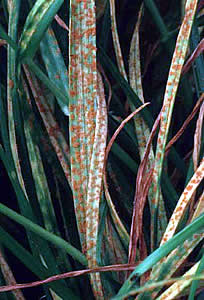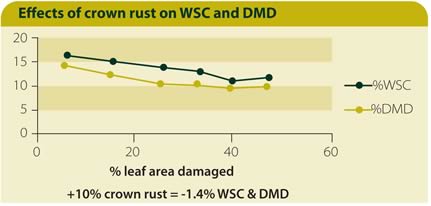 |
|||||||||
|
|||||||||||||||||||
|
|
Certain Ryegrass Varieties Can Minimise Crown Rust Problem 06/08/08 Crown rust resistance should be a key consideration for farmers when selecting grass varieties for this autumn’s reseeding in order to minimise the increasing threat from this potentially costly fungal disease, advises British Seed Houses.
According to the company’s agricultural director Paul Billings, a combination of global warming and reduced nitrogen fertiliser use means swards are being affected more commonly and further northwards, to the detriment of pasture productivity. “We are now seeing crown rust on grassland as far north as Yorkshire,” he reports, “and even at low infection levels the characteristic orange spores on the leaves depress intakes and nutritional quality of the grass. Work carried out at the former Institute of Grassland and Environmental Research (IGER) showed that an infection level of just 10% results in a 1.4% reduction in dry matter digestibility (D-value). Work at NIAB has show that a 1 point reduction in D-value equates to a 5% decrease in animal performance, so even low level crown rust infections are very costly. In more extreme cases crown rust will cause long term damage to swards and accelerate the need for reseeding.” Mr Billings points out that farmers can minimise the problem in affected swards by avoiding grass becoming too long (topping if necessary) and ensuring grassland has sufficient nutrients to combat the fungus. However, reseeding with the right varieties is the long term solution, and not only for the greater resistance offered by some ryegrass varieties. “There is significant variation in the resistance of different ryegrass varieties to crown rust, but most Aber ryegrasses score favourably due to a the long term breeding strategy at IGER (now IBERS),” he adds.
“It is also worth noting that many weed grass species have increased susceptibility to crown rust and other diseases, so in addition to reducing the yield and quality of the sward, weed ingress is increasing the disease risk. This creates an additional argument for timely reseeding. Inclusion of clover will also reduce the sward’s overall susceptibility to crown rust.” Farmers are advised to check the susceptibility of ryegrasses to crown rust as well as other potential diseases when planning their reseeding. Seed merchants or distributors that are participants in the Grass Levy Scheme will have full access to relevant trial data and information and will be best placed to make recommendations.
|
||||||||||||||||||

|
|
||||||||||||||||||
| home | agri-services | pedigree
pen | news | dairy | beef | machinery property | organisations | site map |
|||||||||||||||||||

